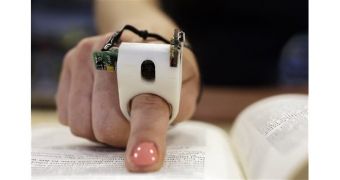Text-to-speech technology isn't a new thing, but it's not exactly all that refined either, with the electronic voice tending to grate on people's nerves as much as it helps with communication. The MIT may have just made a significant leap in this field, however.
A team of scientists from the Massachusetts Institute of Technology have created an audio reading device which, when worn on the index finger, will read aloud to the person wearing it.
It is like having a ring that will read to you the words on the book line your are tracing with the tip of your finger. It may not be a particularly compact or good-looking finger, but that will hardly matter.
After all, people who are blind or otherwise visually impaired won't be able to make out the details of the accessory anyway, assuming they even feel the need to squint at it in the first place.
MIT dubbed the latest device simply as FingerReader and, as amazing as it may sound, used 3D printing technology to craft it. A small camera scans the text as your finger traces it, and a synthesized voice reads the words.
Intonation isn't the best, but the functionality will surely come in handy when faced with a restaurant menu, newspaper or ingredient list on a recipe.
If the wearer happens to be particularly easygoing, patient and willing to kill some time, the device will do well enough in reading a book as well.
Being able to read forms before signing them when visiting the doctor's office will also be useful. In fact, it was one of the strong points seen by 62-year-old Jerry Berrier, who was born blind and has tested the FingerReader recently.
He has mentioned that he knows of no other device that can read things in real time, which means there really isn't or it's not affordable enough for most prospective customers to bother with.
Berrier oversees training and evaluation for a federal program that distributes technology to low-income people who have lost their sight and hearing, and who live in Massachusetts and Rhode Island. Given that, it's safe to assume he knows what he is speaking about.
There is similar technology for homes and offices, but it relies on large scanners and the script needs time to be processed before it can be read aloud.
All in all, being able to read with the tip of your finger (as said by MIT professor and FingerReader research group leader Pattie Maes) beats living in silence. It's also better than having to settle for the comparatively few Braille texts that exist. Besides, Braille isn't something you can expect a restaurant menu to be written in.
It took three years of software coding and design experimentation to make the prototype you see above, and it still needs some work (it can't read text from a touchscreen, for instance, since that moves the text around). When it's ready, however, it will be compatible with phones and sell for an affordable sum, though no number has been provided yet.

 14 DAY TRIAL //
14 DAY TRIAL //